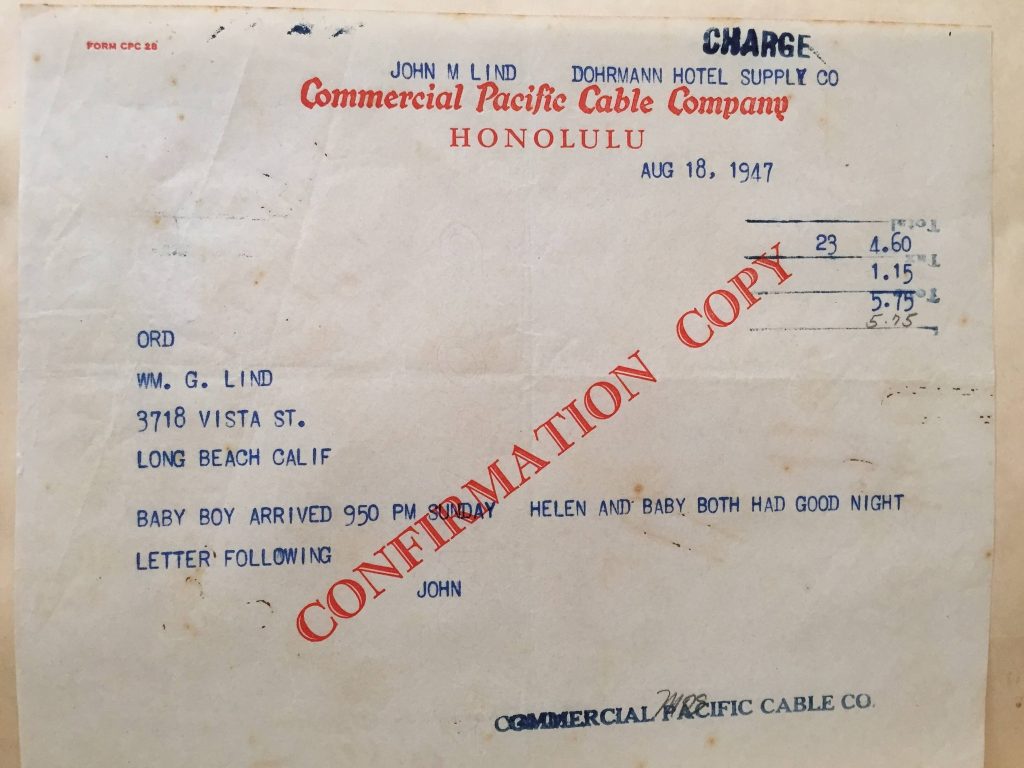Here’s an item I shared on Facebook, and the positive reaction leads me to reposts it here.
Still digging through old scans, I came across this 78-year old telegram that my dad sent to his mother in Long Beach, California, letting her know about the birth of his son.
The cable was brief and to the point. It did not go further to explain that I entered the world two months prematurely, and at that time my mother’s physician advised my parents not to select a name immediately, because that would make it more difficult emotionally if I didn’t survive. And, at least based on that advice, it would seem that the odds of survival were not in my favor. Perhaps that back story was included in the letter that followed. I don’t know.
Think about how different the world was then. No instant text messaging. No phone in your pocket capable of inexpensive international calls. At that time, even a brief telephone call to announce a birth to your parents was prohibitively expensive!
This message cost $5.75 to send.
According to the all-knowing internet, that would be just over $83 in 2025 dollars.
I’ll bet today’s college students have no clue that long-distance communications relied on this and other long-gone methods.
According to an online history of cable communications, Commercial Pacific Cable Company was a collaboration founded in 1901.
The Commercial Pacific Cable Company was formed by a collaboration of the Commercial Cable Company, the Great Northern Telegraph Company, and the Eastern Telegraph Company, with the goal of laying a cable across the Pacific Ocean from America’s west coast.
Founded in 1901, the company provided the first direct telegraph route from America to the Philippines, China, and Japan. Prior to this, messages had to travel across the Atlantic to the Far East via Capetown and the Indian Ocean, or via London to Russia, then across the Russian landline to Vladivostock, then by submarine cable to Japan and the Philippines.
The same history notes that the link between San Francisco and Honolulu was “the first and most significant section,” and was laid down in 1902.
The company ceased operations in October 1951 and was merged into AT&T.
Google’s AI explained several reasons why telegrams have not yet completely disappeared.
Why telegrams are still sent
Legal Purposes:
Telegrams are a strong, legally recognized document for matters like contract cancellations or other legal notifications because the service keeps a time-stamped copy for verification in court.Formal Communication:
They are considered a formal way to send important messages and are seen as more official than emails or text messages, notes Quora.Special Occasions:
Telegrams are used to mark significant social events like weddings, graduations, or to express sympathy for deaths, offering a unique and memorable way to celebrate or express feelings.Urgency and Importance:
They are still considered the “gold standard” for urgent, official, or significant messages, notes Atlas Obscura.How telegrams are sent today
Online ordering: Most services allow you to order and send a telegram online.
Hand-delivery: The message is still printed on paper and hand-delivered to the recipient’s door, often in a sealed envelope.Company services: Companies like International Telegram, American Telegram, and others operate the former Western Union network, providing the infrastructure for these messages to be sent across the globe.
Discover more from i L i n d
Subscribe to get the latest posts sent to your email.


Not only long gone, but pricey. Long distance calls were the is this so important a call that it’s worth the cost? Shooting film photos were the is this shot worth using one of my 24 or 36 pictures? Now days, the, 500 photos on a trip, no problem. Back then two rolls? Three. Let’s not get carried away here. You know most of them are going to kind of suck.
and soon after the telegraph line reached Hawaii in 1902 the Mutual Telephone Company had merged with another and set up radio links to the other islands local telegraph systems (radio at first was just radio-telegraph bursts, they couldn’t tune it), followed by Marconi’s 1913 most-powerful-radio-telegraph in the world, in Kahuku. Mutual had to relocate their transmitter to Wahiawa to avoid the interference caused by the Marconi double-electric-generator lightning-bolt like signal. Soon the Navy in WWI took over and quickly learned to ‘tune’ the radio and handle multiple messages at once. RCA Victor ended up with the virtual monopoly Marconi sought to secure.